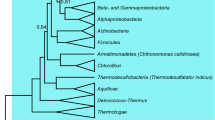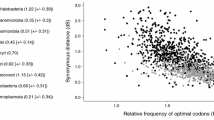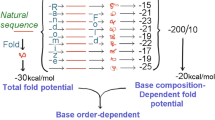Abstract
To study the evolution of mutation biased synonymous codon usage, we examined nucleotide co-occurrence patterns in the Deinococcus radiodurans, D. geothermalis, and Thermus thermophilus genomes for nucleotide replacement dependent on the surrounding nucleotide context. Nucleotides on the third codon site were found to be strongly correlated with nucleotide sites at most six nucleotides away in all three species, where abundance patterns were dependent on whether two nucleotides share the same purine(R)/pyrimidine(Y) status. In the class Deinococci adjacent third site nucleotides were strongly correlated, where NNR|NNR and NNY|NNY codon pairs were overabundant while NNR|NNY and NNY|NNR codon pairs were underabundant. By far the largest deviations in all three species occur for NN(YR)|(YR)NN codon pairs. In the Thermus species, the NNY|YNN and NNR|RNN codon pairs were overabundant versus the underabundant NNY|RNN and NNR|YNN codon pairs, whereas in the Deinococcus species the opposite over-/underabundance relationship held for adjacent (GC) bases. We also observed a weaker overabundance of NNR|NRN and NNY|NYN codon pairs versus the underabundant NNR|NYN and NNY|NRN codon pairs. The perfect purine/pyrimidine symmetry of each of these cases, plus the lack of significant deviations for nucleotide pairs on other length scales up to 20 codons apart demonstrates that a pervasive pattern of nucleotide replacement dependent on local nucleotide context, and not codon bias, has occurred in these species. This nucleotide replacement has led to modified synonymous codon usage within the class Deinococci that affects which codons are positioned at particular codon sites dependent on the local nucleotide context.







Similar content being viewed by others
References
Anderson AW, Nordon HC, Cain RF, Parish G, Duggan D (1956) Studies on a radio-resistant Micrococcus. I. Isolation, morphology, cultural characteristics, and resistance to gamma radiation. Food Technol 10:575–578
Battista JR (1997) Against all odds: the survival strategies of Deinococcus radiodurans. Annu Rev Microbiol 51:203–224
Berg OG, Martelius M (1995) Synonymous substitution-rate constants in Escherichia coli and Salmonella typhimurium and their relationship to gene expression and selection pressure. J Mol Evol 41(4):449–456
Berg OG, Silva PJN (1997) Codon bias in Escherichia coli: the influence of codon context on mutation and selection. Nucleic Acids Res 25:1397–1404
Bessman MJ, Frick DN, O’ Handley SF (1996) The MutT proteins or “Nudix” hydrolases, a family of versatile, widely distributed, “house cleaning” enzyme. J Biol Chem 271:25059–25062
Brim H, McFarlan SC, Fredrickson JK, Minton KW, Zhai M, Wackett LP, Daly MJ (2000) Engineering Deinococcus radiodurans for metal remediation in radioactive mixed waste environments. Nature Biotech 18:85–90
Cleston LC, Wackett LP, Minton KW, Daly MJ (1998) Engineering a recombinant Deinococcus radiodurans for organopollutant degradation in radioactive mixed waste environments. Nature Biotech 16:929–933
Coulondre C, Miller JH, Farabaugh PJ, Gilbert W (1978) Molecular basis of base substitution hotspots in Escherichia coli. Nature 274:775–780
Counsell TJ, Murray RGE (1986) Polar lipid profiles of the genus Deinococcus. Int J Syst Bacteriol 36:202–206
Cutler RW, Chantawannakul P (2007) The effect of local nucleotides on synonymous codon usage in the honeybee (Apis mellifera L.) genome. J Mol Evol 64:637–645
Duret L (2000) tRNA gene number and codon usage in the C. elegans genome are co-adapted for optimal translation of highly expressed genes. Trends Genet 16:287–289
Ferreira AC, Nobre MF, Rainey FA, Silva MT, Wait R, Burghardt J, Chung AP, da Costa MS (1997) Deinococcus geothermalis sp. nov. and Deinococcus murrayi sp. nov., two extremely radiation-resistant and slightly thermophilic species from hot springs. Int J Syst Bacteriol 47:939–947
Grantham R, Gautier C, Gouy M, Mercier R, Pave A (1980) Codon catalog usage and the genome hypothesis. Nucleic Acids Res 8:49–62
Grosjean H, Fiers W (1982) Preferential codon usage in prokaryotic genes: the optimal codon-anticodon interaction energy and the selective codon usage in efficiently expressed gene. Gene 18:199–209
Gu W, Zhong T, Ma J, Sun X, Lu Z (2004) The relationship between synonymous codon usage and protein structure in Escherichia coli and Homo sapiens. Biosystem 73:89–97
Ikemura T (1981) Correlation between the abundances of Escherichia coli transfer RNAs and the occurrence of the respective codons in its protein genes: a proposal for a synonymous codon choice that is optimal for the E. coli translation system. J Mol Biol 151:573–597
Ikemura T (1982) Correlation between the abundance of yeast transfer RNAs and the occurrence of the respective codons in protein genes. Difference in synonymous codon choice patterns of yeast and Escherichia coli with reference to the abundance of isoaccepting transfer RNAs. J Mol Biol 158:573–597
Karlin S, Mrázek J, Cambell AM (1997) Compositional biases of bacterial genomes and evolutionary implications. J Bacteriol 179(12):3899–3913
Karlin S, Campbell AM, Mrázek J (1998) Comparative DNA analysis across diverse genomes. Annu Rev Genet 32:185–225
Lange C, Wackett LP, Minton KW, Daly MJ (1998) Engineering a recombinant Deinococcus radiodurans for organopollutant degradation in radioactive mixed waste environment. Nature Biotech 16:929–933
Lui Q (2006) Analysis of codon usage pattern in the radioresistant bacterium Deinococcus radiodurans. Biosystems 85:99–106
Makarova KS, Wolf YI, White O, Minton K, Daly MJ (1999) Short repeats and IS elements in the extremely radiation-resistant bacterium Deinococcus radiodurans and comparison to other bacterial species. Res Microbiol 150:711–724
Masters CI, Murray RG, Moseley BE, Minton KW (1991) DNA polymorphisms in new isolates of Deinococcus radiopugnans. J Gen Microbiol 137:1459–1469
Matsuzaki M, Misumi O, Shin-i T, Maruyama S, Takahara M, Miyagishima S, Mori T, Nishida K, Yagisawa F, Nishida K, Yoshida Y, Nishimura Y, Nakao S, Kobayashi T, Momoyama Y, Higashiyama T, Minoda A, Sano M, Nomoto H, Oishi K, Hayashi H, Ohta F, Nishizaka S, Haga S, Miura S, Morishita T, Kabeya Y, Terasawa K, Suzuki Y, Ishii Y, Asakawa S, Takano H, Ohta N, Kuroiwa H, Tanaka K, Shimizu N, Sugano S, Sato N, Nozaki H, Ogasawara N, Kohara Y, Kuroiwa T (2004) Genome sequence of the ultrasmall unicellular red alga Cyanidioschyzon merolae 10 D. Nature 428:653–657
McVean GAT, Hurst GDD (2000) Evolutionary liability of context dependent codon bias in bacteria. J Mol Evol 50:264–275
Merkl R (2003) A survey of codon and amino acid frequency bias in microbial genomes focusing on translational efficiency. J Mol Evol 57:453–466
Minton KW (1994) DNA repair in the extremely radioresistant bacterium Deinococcus radiodurans. Mol Microbiol 13:9–15
Mita KS, Ichimura MZ, James TC (1988) Specific codon usage pattern and its implications on the secondary structure of silk fibroin mRNA. J Mol Biol 203:917–925
Morton BR (1998) Selection on the codon bias of chloroplast and cyanelle genes in different plant and algal lineage. J Mol Evol 46:449–459
Narumi I (2003) Unlocking radiation resistance mechanisms: still a long way to go. Trends Microbiol 11(9):422–425
Omelchenko MV, Wolf YI, Gaidamakova EK, Matrosova VY, Vasilenko A, Zhai M, Daly MJ, Koonin EV, Makarova KS (1995) Comparative genomics of Thermus thermophilus and Deinococcus radiodurans: divergent routes of adaptation to thermophily and radiation resistance. BMC Evol Biol 5(57):1–22
Sharp PM, Stenico M, Peden JF, Lloyd AT (1993) Codon usage:mutational bias, translational selection, or both? Biochem Soc Trans 21:835–841
Sueka N, Kawanishi Y (2000) DNA G + C content of the third codon position and codon usage biases of human gene. Gene 261:53–62
Consortium The Honey Bee Sequencing (2006) Insights into social insects from the genome of the honeybee Apis mellifera. Nature 443:931–949
White O, Eisen JA, Heidelberg JF, Hickey EK, Peterson JD, Dodson RJ, Haft DH, Gwinn ML, Nelson WC, Richardson DL, Moffat KS, Qin H, Jiang L, Pamphile W, Crosby M, Shen M, Vamathevan JJ, Lam P, McDonald L, Utterback T, Zalewski C, Makarova KS, Aravind L, Daly MJ, Minton KW, Fleischmann RD, Ketchum KA, Nelson KE, Salzberg S, Smith HO, Venter JC, Fraser CM (1999) Genome sequence of the radioresistant bacterium Deinococcus radiodurans R14. Science 286:1571–1577
Woese CR (1987) Bacterial evolution. Microbiol Rev 51(2):221–271
Wolfe KH, Sharp PM, Li W-H (1989) Mutation rates differ among regions of the mammalian genome. Nature 337:283–285
Acknowledgments
This research was conducted using funding from the Chiang Mai University Fund. We would like to thank the Bee Protection center, Faculty of Science, Chiang Mai University, for providing the facilities used in this research.
Author information
Authors and Affiliations
Corresponding author
Rights and permissions
About this article
Cite this article
Cutler, R.W., Chantawannakul, P. Synonymous Codon Usage Bias Dependent on Local Nucleotide Context in the Class Deinococci . J Mol Evol 67, 301–314 (2008). https://doi.org/10.1007/s00239-008-9152-y
Received:
Accepted:
Published:
Issue Date:
DOI: https://doi.org/10.1007/s00239-008-9152-y




